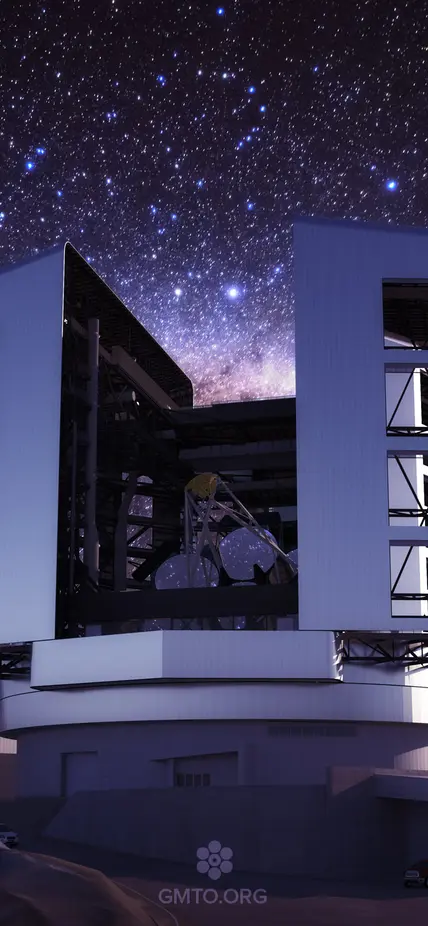From unveiling the intricate details of distant exoplanets to shedding light on the elusive nature of dark matter, the Giant Magellan Telescope promises a treasure trove of discoveries that will captivate stargazers and scientists alike.
In anticipating the Giant Magellan’s transformative impact, we asked a selection of Carnegie Science leaders and astronomers to tell us how this next-generation telescope will change their field of research. Their enthusiasm is contagious, and their visions for exploration are bound to inspire curiosity and wonder.
How will the Giant Magellan impact astronomy?
Eric D. Isaacs | President of Carnegie Science

"The 25-meter Giant Magellan, under construction at Carnegie Science's Las Campanas Observatory, will launch a new era of discovery in astronomy, astrophysics, and cosmology. With 10 times the area and four times the spatial resolution of the James Webb Space Telescope, the Giant Magellan will enable us to see further back in time to the first generation of stars and galaxies and will allow the resolution of exoplanets and their atmospheres. Its cutting-edge instrumentation suite, along with adaptive optics will give astrophysicists the tools to probe the nature of dark matter and dark energy and expand the search for important biosignatures like oxygen and ozone in the atmospheres of planets in our galactic neighborhood."
John Mulchaey | Deputy for Science, Observatories Director & Crawford H. Greenewalt Chair

"One of the great things about the Giant Magellan is that it is an all-purpose telescope. It will have an impact on almost all areas of astronomy and astrophysics. It's a powerful instrument that a significant fraction of the astronomers in the country will be using."
What will the Giant Magellan tell us about distant planets?
Johanna Teske | Earth and Planets Laboratory

"The Giant Magellan is going to enable studies of exoplanets that has just not been possible before. It's not ideal for broad, demographic studies of many exoplanets, but will be excellent for drilling down into the detailed properties of a small subset, helping us measure the compositions of those planets in unprecedented detail.
This is important for understanding where we might look for habitable conditions on other worlds—maybe even finding evidence of such conditions! It will also have the power to find new planets, either those that are too small or in too long of orbits to have been detected with current instrumentation.
The Giant Magellan has the potential to really push our planet detection and characterization into the Earth analog regime."
Peter Gao | Earth and Planets Laboratory

"The Giant Magellan has the potential to fundamentally advance our knowledge of life in the universe by being able to detect biosignatures on Earth-like planets through high-resolution spectroscopy. That's a pretty big deal!"
What will the Giant Magellan tell us about planetary systems?
Alycia Weinberger | Earth and Planets Laboratory

"As astronomers on Earth, we're stuck with the fact that the closest clusters with large numbers of young stars—and therefore with developing planetary systems—are about 450 lightyears away.
To study these systems in detail, we need to collect a lot of light and we need to see them in detail so we can distinguish what's going on in the inner system—akin to where we find our terrestrial planets—from the outer system—akin to where we find our gas giants.
Both of these requirements are met by a 25-meter telescope like the Giant Magellan.
Of course, it's not good enough to look at just one or a few forming planetary systems. We know there is a huge diversity of exoplanets out there. I want to know why certain stars form different kinds of planets. Are they very close-in? A mixture of rock and water? Nice and temperate like Earth? Large and gassy? The Giant Magellan will be able to look at a large swath of stars for this kind of detail for the first time."
What will the Giant Magellan Telescope tell us about stars and galaxies?
Drew Newman | Observatories

"Telescopes let us look back in time and witness the early stages of galaxy formation — but only if we can observe very distant galaxies, which are small and faint. One of the Giant Magellan's revolutions will come from its ability to create extremely sharp images.
That will allow us to see inside early galaxies so that we can follow the evolution of their constituent parts over cosmic time. I think another revolution will be to reveal the hidden side of early galaxies and the enormous reservoirs of gas and dark matter that we think surround them."
Gwen Rudie | Observatories

"The Giant Magellan will revolutionize our ability to see and study galaxies in relation to their cosmic ecosystems. The gas surrounding distant galaxies provides some of the most important insights into poorly understood processes that regulate the way in which galaxies form stars."
What will the Giant Magellan Telescope tell us about dark matter?
Josh Simon | Observatories

"Several years ago, I led the U.S. community effort to develop plans for investigating dark matter with extremely large telescopes. There are two approaches that look promising.
One will determine the distribution of dark matter within tiny dwarf galaxies orbiting the Milky Way by measuring the motions of very faint stars with the Giant Magellan, which is one of the areas that I've specialized in. The other will search for clumps of dark matter that were too small to form galaxies with observations of gravitational lens systems.
Both of these projects have the potential to provide major new clues to the nature of dark matter."
What will the Giant Magellan Telescope tell us about our Solar System?
Scott Sheppard | Earth and Planets Laboratory

"Many of the Solar System objects we are finding beyond Pluto are to us currently just faint points of light since they are so far away. The Giant Magellan will allow us to characterize the surface of these distant worlds for the first time to understand their compositions and to see how rich organics and ices are in these objects in the outer Solar System. The ingredients for life might be found in abundance in these distant worlds."
Are you planning to use the Giant Magellan for your research?
Absolutely! I plan to be involved in using the Giant Magellan to measure the masses of small rocky exoplanets and their atmospheric composition to understand the diversity of rocky planets in the galaxy.
Are we living in a galaxy of Venuses or Earths or something else? I hope to use the Giant Magellan to answer this question.
Absolutely.
The starlight that we readily see in images of galaxies only shows part of the story. We think that much of the action in galaxy formation is happening in the surroundings, but it is very hard to see. One way to see the diffuse gas around a galaxy is to detect the shadows it casts on other galaxies in the background. The problem has been that most of those background galaxies are too faint to observe in any detail—but not for the Giant Magellan.
I plan to use the Giant Magellan to image much fainter than our current technology efficiently allows. These ultra-deep images will allow us to find fainter and, thus, more distant objects far beyond Pluto.
I definitely hope to use GMT for my research!
I would like to use it to find new small planets orbiting nearby stars as well as measure the compositions of exoplanet atmospheres. Right now, I'm very interested in surveying the atmospheres of planets between the size of Earth and Neptune, to take a chemical inventory, but even with the best instruments on JWST, this is challenging in part due to their low resolving power.
With these low-resolution observations, our view can be obscured by clouds or hazes that absorb and scatter light in small planet atmospheres; it seems like at least some small planets have cloudy or hazy atmospheres. This is interesting in its own right but doesn't tell us about the atmospheric compositions.
However, with higher resolving power instruments on GMT, we can effectively see "above" the clouds or hazes and perhaps still successfully determine the planet's atmospheric composition, e.g., do they have water?
Given all of my responsibilities as Deputy for Science and Director of the Observatories, I don't get much time to do my own research these days. But I very much look forward to hearing about the work other Carnegie astronomers will do with the telescope!
One thing that I’m excited to do with the Giant Magellan is to map out what you might call galaxy ecosystems—the flows of gas that young galaxies exchange with their surroundings. This is one of the least understood yet most important drivers of galaxies’ evolution.
The Giant Magellan will give us critical new eyes to see the motion of gas flying out of galaxies - pushed out by enormous amounts of energy released by hot massive stars and their explosive deaths. At the same time, it will allow us to map in detail—for the first time—the distribution, motion, and chemistry of gas surrounding galaxies providing us the first complete snapshot—not just of distant galaxies, but of the atmosphere surrounding them from which the gain the gas to form new stars and pollute with the products of previous star formation.
I am absolutely planning to use the Giant Magellan for my research! One early project will be studying dark matter in nearby dwarf galaxies. I am hoping to complete a long-sought test of dark matter theories based on the Giant Magellan's measurements of the most dark matter-dominated galaxies. The chemical abundances of stars in the same galaxies have also provided new insights into cosmic nucleosynthesis, but there are very few stars in these systems that are bright enough to derive their detailed chemical composition with current telescopes. The Giant Magellan will enable us to observe significantly more of these stars, which are some of the oldest in the universe.
I want to study the material—the gas and dust—that we think terrestrial planets like Earth formed from. We want to find out what the material is made of, how long it lasts, whether it differs around different types of stars, how it changes over time and so many other details.
To do this, I'm most excited about two of the instruments that will be on Giant Magellan: GMTNIRS, which is a high-resolution infrared spectrometer; and GMag-AO-X, which will correct for the Earth's atmosphere to make incredibly detailed images of disks. We have to connect planet formation to the panoply of exoplanets, so I also hope we'll be able to look at very young planets in disks with both of them.
I'm helping to develop the science cases for both of these instruments, which then dictate their technical requirements. I'm currently using the prototype instrument for GMag-AO-X, which is MagAO-X, on our Magellan Clay telescope. I'm also working to build GMTNIRS and install it on Magellan before the Giant Magellan is ready for it. Once it’s on the Magellan, we're going to call it MagNIFIES.
What are you most excited about when the Giant Magellan comes online?
I am excited about how we'll be able to finally shed light on the nature of low-mass planets in the galaxy and their habitability.
Seeing the sharpest images ever made of galaxies in the early universe!
I'm most excited to see the Giant Magellan in action. To have an arena-sized telescope dome moving in real time will be an amazing sight to see. The giant leap in our imaging ability with GMT will revolutionize astronomy and the things we know about the solar system and universe. The Solar System, in general, will become a much smaller place as we will be able to image very distant worlds in much greater detail.
I am excited to go there and use it myself.
One of my favorite parts of my job is being at the telescope, seeing the instruments, (trying to) understand how everything works and fits together. That's what got me into astronomy.
I'm not a religious person, but they represent something scientifically "sacred" to me. For me, telescopes are my alters for worshipping the deep power of and drive towards discovery.
The first generation instrumentation for the Giant Magellan makes it an especially good telescope to study exoplanet atmospheres. Our hope is that it will be the telescope that allows us to definitively detect the signatures of life elsewhere. That is probably the existing science that I'm most excited about.
Anytime we have a leap in telescope abilities like this, the universe always surprises us with things we were not expecting. So, in that sense, the most exciting things the Giant Magellan will study are the things we don't know about at all.
The surprises. The projects my colleagues and I have in mind will certainly create new knowledge and understanding of our universe. But when we build new, more powerful telescopes and instruments allowing us to see fainter and farther, it's the surprises the universe gives us that tend to teach us the most. So, I'm most excited to see what unanticipated revelations await us.
The first 10-meter telescopes were built 30 years ago, and they have not yet been exceeded. I'm excited that we'll finally have new tools that are significantly more powerful than any that have been available in my career thus far.
Science-wise, I'm excited about the dwarf galaxy observations mentioned above, but I also think that the Giant Magellan will provide amazing opportunities to learn more about the properties of exoplanets, even though I don't work very much on those.
The universe will always surprise us, and I like surprises.
I expect we'll point GMT at some well-loved sources that we know a lot about already, and discover something new and unexpected. Astronomy is an exploratory science. We make predictions and hypotheses based on what we know now, but as Emerson wrote, “Nothing is rich but the inexhaustible wealth of nature. She shows us only surfaces, but she is a million fathoms deep."
I have that quote on my wall because it's the inspiration for being an astronomer.

